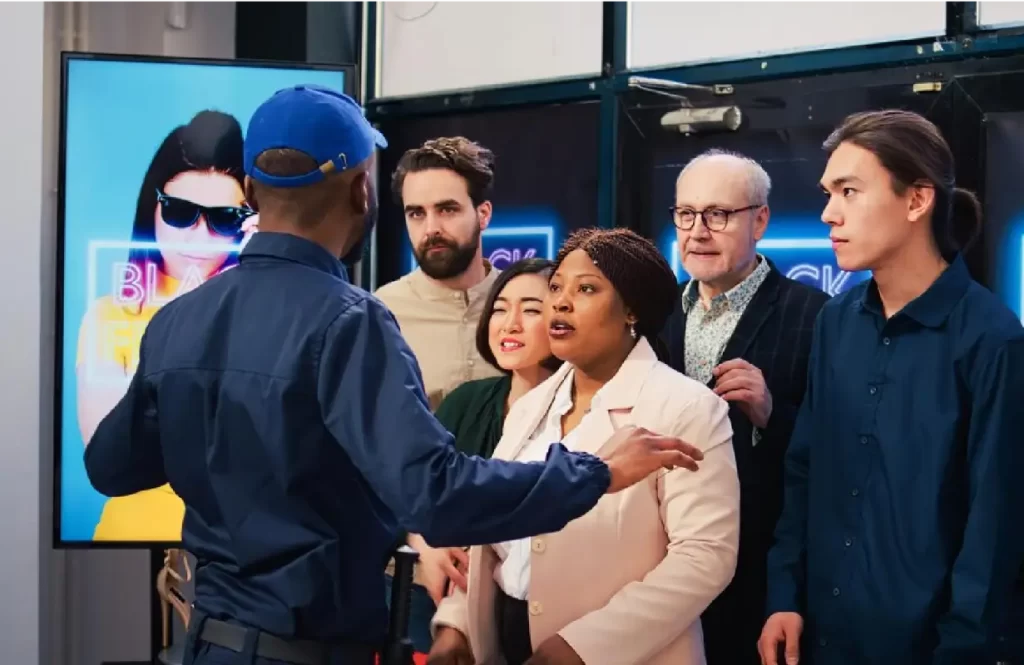Managing Large Crowds and Public Interactions Effectively
Why This Skill Matters
Large crowds can quickly become unpredictable—whether in a shopping centre, stadium, retail park, or transport hub. For security officers, the challenge is not only to maintain safety but to manage interactions professionally and politely so that the organisation’s reputation is protected. How you communicate and control the environment will determine whether people feel safe and respected—or stressed and unsafe.

Key Principles of Crowd Management
Visibility and Presence – Being clearly visible reassures the public and deters disorderly behaviour. A confident, approachable presence encourages cooperation.
Communication First – Clear instructions, given calmly and politely, prevent confusion and reduce frustration in large groups.
Proportionate Control – Use the minimum intervention necessary. Heavy-handed behaviour in front of crowds can damage reputation and trigger backlash.
Team Coordination – Effective communication with colleagues (using radios or hand signals) ensures consistent, controlled responses.
Statistic: The British Safety Council reports that well-managed security presence reduces incidents in large gatherings by up to 40%.
Recognising Early Warning Signs
Crowds rarely become disorderly without warning. Security officers must learn to recognise early signs of tension such as raised voices, pushing in queues, or groups gathering too closely. By identifying these behaviours early, you can act before the situation escalates.
Example: At a transport hub, officers noticed a small group becoming agitated in a long queue. Instead of waiting for the situation to escalate, they calmly opened an additional entry point and explained the process clearly. The tension eased, and the rest of the crowd followed instructions peacefully.
Tips:
Scan continuously—look for body language, facial expressions, or restlessness.
Intervene politely at the first sign of frustration.
Use positive language: “We’ll be moving shortly” rather than “Stop complaining.”
Real-World Example
During a seasonal sales event in a London shopping centre, footfall spiked beyond expectations. Long queues and impatient customers could have escalated into disorder. Security officers managed the situation by:
Directing crowds with clear, polite instructions.
Setting up barriers to maintain safe flow.
Reassuring customers through calm communication.
As a result, no incidents occurred, customer feedback praised the “helpful security staff,” and local press reported positively. This shows how professional, polite crowd management enhances both safety and corporate reputation.
Risks of Poor Crowd Management
> Aggressive Behaviour
Responding with raised voices, threats, or physical intimidation often makes situations worse. Instead of calming people, it escalates tensions, damages public trust, and risks being recorded and shared online—leading to viral backlash and reputational harm for both the officer and the organisation.
> Lack of Visibility
When officers are not clearly seen or appear disengaged, crowds feel unsafe. A low profile can invite theft, disorder, or panic, as people believe no one is in control. Visibility is a deterrent and a reassurance—without it, risk increases sharply.
> Poor Communication
If instructions are unclear, inconsistent, or delivered in a dismissive tone, crowds may become frustrated or ignore directions altogether. This confusion can create bottlenecks, non-compliance with safety rules, and unnecessary conflict.
> Breach of Professional Standards
Failure to follow SIA regulations, BSI codes of practice, or the Equality Act 2010 exposes both the officer and the employer to complaints, disciplinary measures, or contract loss. Non-compliance is never just a “small mistake”—it is a professional and legal liability.
Building Public Confidence Through Interactions
Every interaction you have in a crowd is an opportunity to build confidence in security and the organisation. Visitors remember how they were treated—professionalism can turn a stressful situation into a positive experience.
Statistic: According to the British Retail Consortium, over 60% of complaints in crowded environments relate to staff behaviour, not the crowd itself. Professional and polite officers reduce complaints and increase public trust.
Example: During a sporting event, officers were praised for taking time to explain directions and reassure families. While the crowd was large and noisy, the officers’ approachable manner reassured visitors, boosting both the event’s reputation and the security team’s credibility.
Tips:
Treat every member of the crowd as an individual deserving respect.
Smile where appropriate—body language is as powerful as words.
Remember: today’s crowd member could be tomorrow’s customer or client.
Best Practices for Managing Crowds Professionally
Maintain Composure: Stay calm and approachable, even when situations get tense. Your tone sets the mood for everyone around you.
Communicate Clearly and Politely: Use short, respectful instructions like “This way, please” instead of commanding phrases like “Move now.” Clear guidance prevents confusion and keeps people cooperative.
Maximise Visibility: Position yourself where you can be easily seen and monitor the crowd effectively. Being visible deters potential problems and reassures the public.
Intervene Early: Spot signs of frustration or agitation and act promptly with reassurance. Early de-escalation prevents minor issues from turning into bigger incidents.
Protect the Organisation’s Reputation: Treat every interaction as a reflection of the company’s professionalism. Thoughtful, courteous behaviour enhances trust and reinforces the corporate image.
Scenario – The Queue Tension
A large crowd is waiting outside a venue for entry. A group at the back begins shouting that the process is unfair.
| Wrong Approach | Right Approach |
|---|---|
| Yelling back or threatening removal. | Walking calmly to the group and explaining politely: “I understand it’s frustrating, but everyone will be admitted safely. Thank you for your patience.” |
| Outcome: Creates conflict, harms the organisation’s image, and may be filmed and shared online. | Outcome: Shows professionalism, reassures the crowd, prevents escalation, and protects reputation. |
Key Consideration
Managing crowds effectively is not only about control—it is about building trust and protecting reputation. When officers remain calm, polite, and professional, the public sees the organisation as safe, well-organised, and customer-focused. Poor handling, however, can cause immediate reputational harm. Your actions in busy moments shape how the brand is remembered long after the event.

